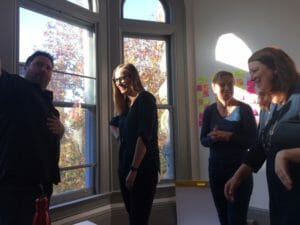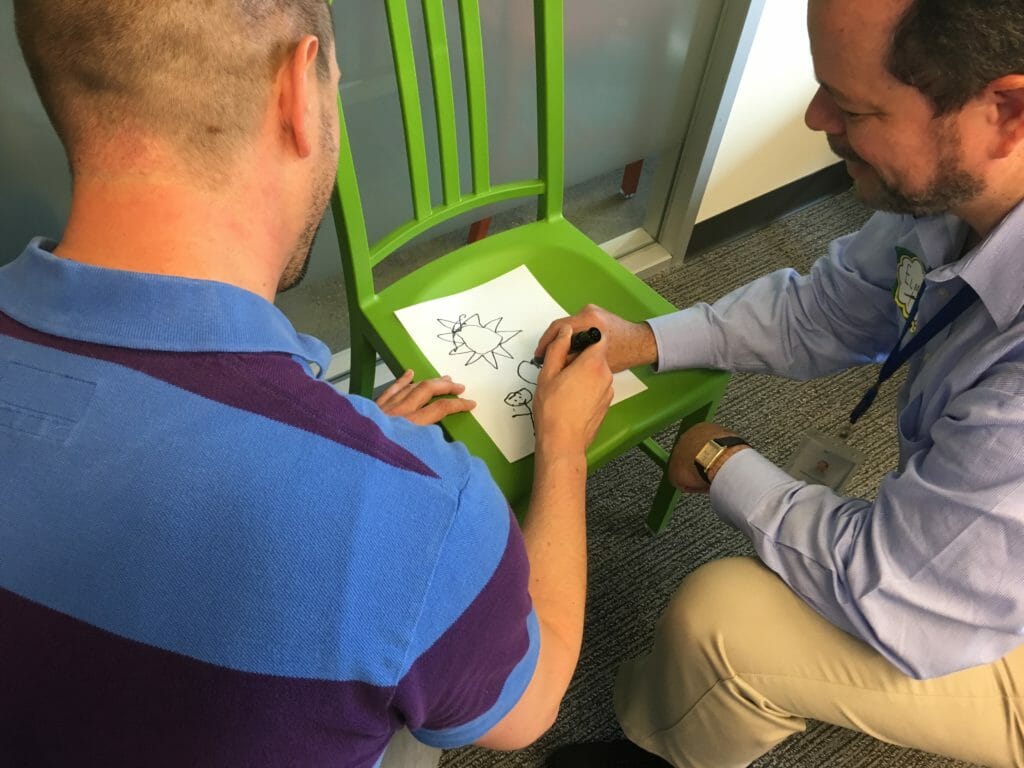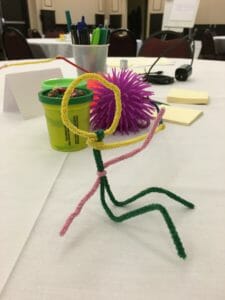Sadly, we’ve all been there: A supposedly creative innovation session like a “brainstorm” that has the same structure and tone of any old status meeting. In my experience, all too often the design of innovation workshops, creative trainings, and collaborative working sessions doesn’t match the intention of the gathering. I’ve been in trainings that were supposed to be “innovative” and “human-centered” and “creative” but turned out to be anything but in the actual delivery, format, and style. Basically, the experience of the session was at odds with the desired outcomes of the session.
When your goal is to get people to be creative, it’s essential to walk the walk. An innovation session should never resemble a traditional meeting because the intention — and what you need to get out of the gathering — is fundamentally different.
[A quick, but important, note as we move forward: We use “innovation session” here, and throughout this article, to cover a wide range of creative and strategic collaborative sessions. To be clear, such sessions do not include status or information sharing meetings.]
The Difference Between Meetings & Innovation Sessions
In a weekly status meeting, the outcome is simple, straightforward updates from your team members on what each is working on and alignment around the tasks at hand. A status meeting, by design, isn’t generative — or creative. In contrast, an innovation session is often about generating new ideas with your team and possibly getting aligned on what to implement and how. In order to do that effectively, you need to create the conditions that will enable the participants in your session to think, act, and produce in line with the spirit of the type of session. You need a participant-centric (or, human-centered) creative session. Avoid the irony of “do as I say, not what I do.” Make sure you walk the walk.
You’ve likely heard of human-centered design (or design thinking), a creative approach to solving problems that puts the people you’re creating solutions for at the heart of the process. Similarly, a participant-centric innovation session puts your participants — their motivations and needs — first. For example, when scoping the objectives for a client for a Mindhatch facilitated innovation session, we ask about business, learning objectives and experience objectives. We go beyond the desired business outcomes and dive in to what type of experience they want their team to have, including how they want attendees to feel.
Your Participants Are Not Ideation Resources to Be “Squeezed”
Whenever I’m designing an innovation or ideation session, I’m reminded of a line from the TV show 30 Rock: CEO caricature, Jack Donaghy, played by Alec Baldwin, calls Liz Lemon, played by Tina Fey, into his office for help and says, “I want to squeeze your mind grapes.” If a creative session isn’t designed with its participants in mind and doesn’t deliver on the promise of being human-centered, it can make your team members feel more like resources to be “tapped” — or grapes to be juiced — rather than true contributors. No employee wants to feel this way. Knowledge workers are motivated primarily by autonomy, mastery, and feeling that they are a part of something meaningful and bigger than themselves. An innovation session is a huge opportunity to deliver on this last motivation.
Although innovation, in particular ideation, is often about extracting ideas from your team and building on those ideas together, it’s important to do so in a way that makes participants feel like they’re getting something out of it, too. If they don’t, it could result in a lack of investment from your team in what was either generated or decided on. And yes, it’s possible to design and execute an innovation session that both nurtures and facilitates.
Running your sessions in such a way isn’t just good for your team, it’s good for your bottom line, too. You can’t avoid the need for team or company-wide gatherings, and they can often be big investments. Time is money.
The best way to make sure you aren’t wasting money is by making sure you aren’t wasting your team’s time.
Designing & Executing a Human-Centered Innovation Session
So, how do you walk the walk when it comes to designing and executing a human-centered innovation session that is going to both give your team a great experience and ensure you get the most out of the occasion? Let’s get started.
1. Carefully Design Your Environment
The environment for an innovation session consists of two key things: The venue, or where the session takes place, and the tone, or the attitude. To choose the right venue and set the appropriate tone, start with your desired outcomes — what you want to get out of your participants. Are you hoping to facilitate team building or creativity? Then make sure the venue and tone are fun. Are you trying to align team members around a strategic decision? Ensure the location is one where the ability to focus is easy.
The location.
As the saying goes, “location, location, location.” It’s true. We can’t stress the importance of venue enough. Many session design elements we reference later are directly impacted by your choice of venue. Although there can be benefits to getting everyone out of the office, we acknowledge that an off-site location isn’t always an option. Regardless, when choosing a location, consider the needs of the type of session you’re hosting. For example, if there will be prototyping during the innovation session, consider a location with access to the customers you’ll need to test the prototypes. If you need people to put on their creative thinking hats, consider non-traditional venues like an art gallery, theatre, or children’s museum. When it comes to choosing a venue, it’s best to let form follow function.
The room.
How will the room at your chosen venue best serve your objectives?
Do you need a war room where your data can live and be worked through? Do you need a place to inspire creativity? Do participants need space to go off and do heads-down, solo work at any point? Do you need lots of clear, open space free of tables (like we use for Organizational Improv sessions)?
For innovation sessions that include sense-making and/or ideation, make sure you have ample wall space as a lack of it can be frustrating to participants and limit divergent thinking. Before booking any hotel meeting room, make sure it doesn’t have carpeted walls; carpeted walls are impossible to tape anything up on, although for sessions that require deep focus, the sound dampening benefits can be helpful. Spaces designated as “meeting” rooms aren’t always suitable for collaborative sessions.

If possible, fight for a room that has windows and natural light as it’s essential for well-being and alertness. Alert participants are key to any type of facilitated session, not just innovative ones. In fact, offices with natural light can reduce eyestrain by 51%, headaches by 63%, and drowsiness by 56%.
If a window just isn’t an option, draw one on a large sheet of paper and stick it up on a visible wall to at least acknowledge that there is no window in the room. Take it one step further with a playful, “We’re all in this dungeon room together!” or something similar so that the participants know that you are on their side. You can bond over cursing the psychopaths who built windowless rooms in the first place.
Set the appropriate tone.
There are many ways you can set the tone for your session. To start, your participants’ experience begins even before they enter the room: Technically, it begins when they receive the meeting invite and/or the agenda and any pre-work. If, for example, you’re going for a fun and energetic tone for your session, use lively playful language for the meeting invite and any meeting documents you provide ahead of time. Make sure all pre-meeting touch points are contributing to the attitude you want people to have when they show up.
Once they do show up, you can make sure your participants feel taken care of with very clear signage for how to get to their session room. In experience design, we call this “wayfinding.” Preventing annoying irritations like not knowing how to get to your destination can go a long way to ensuring that your participants arrive to the room on-time, relaxed, and ready to work.
In the room, consider how the use of music can help put people in the right frame of mind. Create a playlist in advance that you can use as people arrive and also during breaks. If the vibe you’re going for is calm and relaxed, opt for calm and relaxed music. If you need people to be laser-focused on a task, consider instrumental music with no lyrics. If you need people to be upbeat and energized, well… you get the idea!
A good icebreaker or two (at Mindhatch we actually think of these as “tone setters”) is key to kicking things off before diving into the meat of the session. It’s also a good way to show care for your participants, acknowledging what types of apprehensions they may be coming into the session with.
When selecting an icebreaker, consider if everyone in the room is familiar with each other, or if there are many people who are meeting each other for the first time. For the latter, you may want to do a “get to know you” style of icebreaker. If you want participants to be thinking creatively and divergently, consider doing something like 30 Circles to ease them in to the day. If you want everyone to be feeling loose and relaxed, consider choosing an icebreaker that’s more physical. Need everyone to be supportive of one another? An improv activity like FIVE THINGS might be your best bet.
2. Use Activities—and Choose Them Strategically
Creating the right environment with venue and tone is just the first step toward a human-centered innovation session. Now, select the right facilitated content to achieve your desired outcomes.
Make the session activity- and stimuli-based.

Active exercises make for more engaged and motivated participants, and also create a sense that everyone is working together on something larger than their individual selves. It’s also a better alternative to the standard we see in non-creative sessions, which is groups of people passively listening to lectures or speeches. For activity ideas, we recommend the following resources for inspiration:
- Gamestorming
- SessionLab’s Library
- Improv Encyclopedia
- Innovating for People Handbook of Human-Centered Design Methods
- Liberating Structures
Design for the unique personalities and strengths of participants.

It’s also important to take into account the learning or physical limitations of your participants. For someone with dyslexia, for example, design activities that emphasize visual thinking such as drawing, diagramming, and collaging. For an all-day session that might include those with physical limits, vary on-your-feet activities with those that allow for sitting down. You want your activities to be inclusive and mindful of your participants as individuals.
3. Show Care for Your Participants
Just like a car that’s out of fuel will stop working for you, so will your participants if you drive them too hard. Make sure to provide them with the fuel and brain space they need to stay fresh and engaged.
Build in sufficient breaks and decompression time.
For the welfare of your team and quality of ideas, never skip a break for the sake of productivity or making up for time lost. It will backfire.
We’ve run design sprints for clients before and used the Google Ventures sprint methodology, which includes a break every 60 – 90 minutes. While that might not be realistic for every session (time is money after all), it’s a great goal to work toward. Treat breaks as sacred. People need time to rest their brains or think about other things. Otherwise, you’ll get into the danger zone of “squeezing” participants as if they were resources rather than people.
Robert Pozen, a senior lecturer at the MIT Sloan School of Management recommends breaks every 75 – 90 minutes to take advantage of the brain’s two modes: learning/focusing and consolidation. The software startup Draugiem Group found that the most productive workers take 17-minute breaks every 52 minutes. Breaks are essential to both learning, creativity, and productivity. Don’t skip them.
When designing a full-day session, we build in the following break times at minimum: Mid-morning, lunch, (not a working lunch), and a mid-afternoon break. And, of course, always read the room and offer breaks whenever you sense participants could use one. This will allow you to avoid diminishing returns.
Be generous with snacks and meals.
Fuel people’s energies to make sure they feel taken care of and have the physical and mental energy to fully engage in the session. It’s always tempting to reduce the costs of a session by skimping on food, but I guarantee you it’s always worth the investment.
Opt for healthy and nutrition-packed food for steady energy throughout the day. Always keep coffee, water, and a variety of snack options in the room so they don’t have to rely on breaks or leaving the room to get nourishment. And make sure people feel comfortable enough to self serve as needed throughout the day. The last thing you want is distracted participants because they’re counting down the minutes to the next break.
With the tips we’ve outlined above, you can truly transform the way your team ideates, collaborates, makes decisions, and moves forward together. If you ensure your innovation sessions are human-centered, and you walk the walk by making the session design match the intention, the more likely you are to meet your business objectives.

